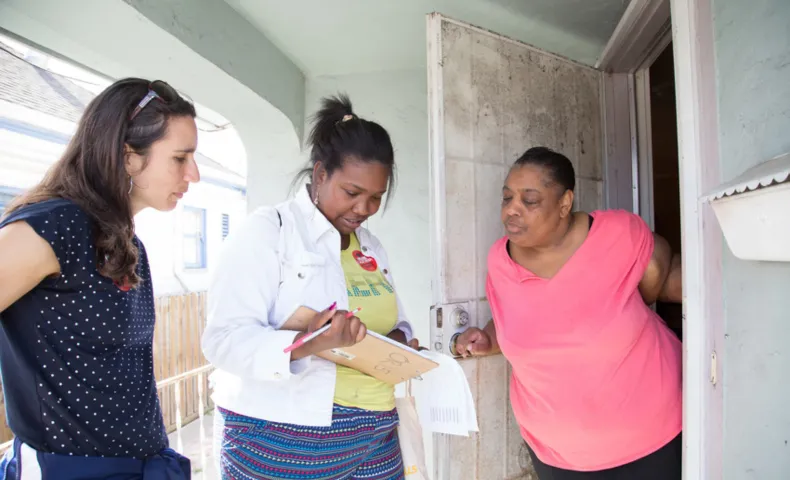
Achieving the Promise of a Multiracial Democracy
In recent years, California has passed numerous reforms making voting and registration easier and more accessible. But despite widespread commitment to expanding voter access, voter turnout numbers in 2022 were down significantly from the 2018 midterm elections.

The Haas, Jr. Fund recently reached out to two of our Democracy Program partners to explore how to get more Californians to the polls, especially voters of color and people from underrepresented communities. Democracy Program Director Raúl Macías spoke with Dr. Lisa García Bedolla and Jonathan Mehta Stein.
García Bedolla is UC Berkeley’s vice provost for graduate studies and dean of the graduate division, and a noted expert on Latino voter engagement. Stein is a civil rights attorney and longtime democracy reform advocate who serves as executive director of California Common Cause.
Q: California has adopted major reforms over the last few years, such as automatic voter registration, same day registration, and sending all voters a ballot. Why is participation still so low?
Dr. Lisa García Bedolla: We’ve seen again and again that when elections are relevant, when money is invested in the field, and when voters actually get messages that resonate with what’s going on with their lives, they turn out to vote. The challenge is that the way we run elections actually means voters are not getting the information and the encouragement they need to turn out.
Political campaigns and political parties are focused on the core voters they are trying to turn out. The result is that huge pieces of the electorate are just not being talked to. The parties don’t really care about that; what matters to them is winning the election. So increasing turnout among populations that historically have been underrepresented in elections and government is work that has to sit outside the partisan structure.
Jonathan Mehta Stein: We’ve made real gains in California in increasing our voter registration numbers, but we are not realizing corresponding and consistent gains in voter turnout. California has passed all of the big ticket policy items in the voting rights landscape. We passed automatic voter registration. We passed same day voter registration, universal access to the vote-by-mail ballot. And yet we continue to see uneven performance on voter turnout and really deep voter participation disparities on the basis of race.
Q: So what is the answer to making the most of California’s reforms and reducing these disparities in voter participation?
Stein: We need to be building a better, more holistic, more representative, and more participatory democracy. Voting rights reforms are part of it. But we also need to make sure that the people who can vote see value and purpose in doing so. That means funding voter education and outreach, and potentially doing that through state dollars. If California sees itself as a partner in building a multiracial democracy in the state, it cannot simply pass good laws and then sit on the sidelines. I think the state has an obligation through the Secretary of State’s office and others to be part of this work.
It also means expanding language access so the large number of California voters whose primary language is not English feel respected and valued and are able to cast a ballot.
Q: What can we do to mobilize voters who aren’t participating?
García Bedolla: We need to integrate new voters better than we’re doing now. If no one’s ever talked to you, if no one’s ever told you that you have power in politics, then why would you believe you have power in politics?
When it comes to Latino voters, or Black voters, or Asian voters, understanding the complexity of the community is also really important. Consider Latino voters as an example. I’m a Cuban who grew up in Los Angeles. I married a Mexican who also grew up in Los Angeles, but we had very different integration experiences. We had very different cultural experiences.
When people reach out to the community in ways that are relevant to them, and meaningful to their day-to-day lives, they turn out and vote. But the sad fact is that many of these communities, they’re just not getting contacted. They’re not getting good information. They don’t really know what’s happening.
Q: And so where can philanthropy make the biggest difference on these issues?
García Bedolla: One thing that needs to happen is we have to look at the connective tissue within these communities. What are the social networks? Who are the people that are the most connected in the schools and the churches, and the other organizations within the community? If you mobilize them, they are connected to all these other folks. So the work is about really trying to find those organizations that can be activated to leverage those connections in order to have exponential impact on the rest of the community.
If you live in a community of color, you may be facing some real challenges when it comes to jobs and healthcare and even environmental issues. But it’s hard to feel and understand your political power until you have a real conversation with somebody like you, someone you can trust. Someone who can say yes, those bad things are happening, but you know what? We can make good things happen if we get more involved in the system and if we vote.
Stein: Facilitating those connections and those conversations requires investment. And where philanthropy can make a difference is in supporting year-round organizing and civic participation, so we aren’t just doing this work around election time but all the time.
Read more about the work being done by Dr. Bedolla’s organization, Data For Social Good here. Read more about California Common Cause’s work to build a stronger democracy here.